#grandee of spain
Photo

✵ October 5, 2011 ✵
Cayetana Fitz-James Stuart, Duchess of Alba & Alfonso Diez Carabantes
12 notes
·
View notes
Text
I just read a detailed account of the Bal des Ifs and I’d never realised how funny this event was when you don’t focus on Madame de Pompadour. All I was taught at school is that it was the masquerade ball in 1745 where Louis XV first took (public) notice of la Pompadour, but what I didn’t know was that the former royal mistress had recently died so there was a vacancy so to speak, and a lot of noblewomen showed up specifically hoping to catch the King’s attention.
But he came dressed up as a shrub (a yew tree similar to the ones in the royal topiary gardens) along with seven other men in identical costumes, so no one knew for sure which one was the King. People always focus on how Madame de Pompadour recognised the royal shrub and talked to him, but what about the women who didn’t!! History is written by the winners but I want to hear about the women who doggedly danced the minuet with random shrubs hoping this one was the one. My book mentions that a determined noble lady followed a yew tree outside the room on a hunch, only to find that she had bet on the wrong shrub. This is what the shrub costumes looked like by the way, imagine stalking one all over the park of Versailles at night because you think his gait looks kingly and you are an ambitious noblewoman
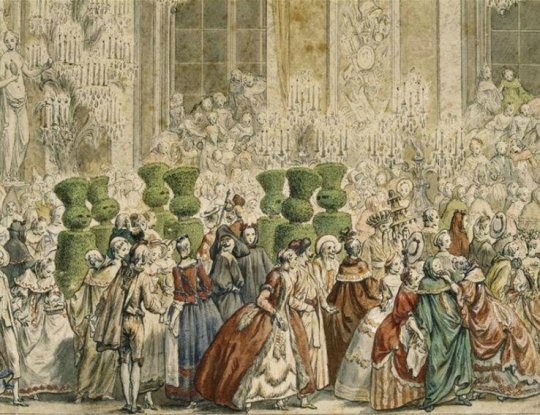
#findings#this ball was a mess! at one point the versailles bouncers gave up on checking the guests and anyone could walk in so#commoners were going in just to fill their pockets with food from the buffet to sell it on the marketplace the next day#the infanta of spain danced with a masked man who was so knowledgeable about spanish royal gossip she believed him to be#a grandee of spain but he turned out to be a former cook at the spanish court#i need to find a book or a thesis on versailles masquerade balls
7K notes
·
View notes
Photo
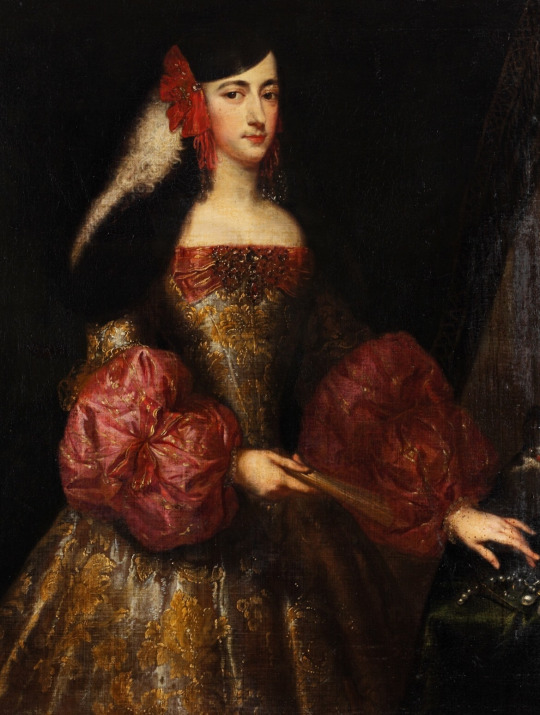
Juan Bautista Martínez del Mazo (Spanish, ca.1612-1667)
Portrait of María Teresa Fajardo de Requesens y Zúñiga, Duchess of Montalto, Grandee of Spain, in her own right 7th Marquise of los Vélez, 1665
Landesmuseum Hannover
#art#fine art#classical art#juan bautista martinez del mazo#potrait of maria teresa fajardo de requesens y zuniga#spanish duchess#spanish#european art#spanish art#duchess#marquise#beautiful art#female portrait#female#portrait#brunette#woman#black hair#black eyes#mediterranean#1600s#spain#noble#nobility#aristocrat#aristocracy#hispanic
19 notes
·
View notes
Text

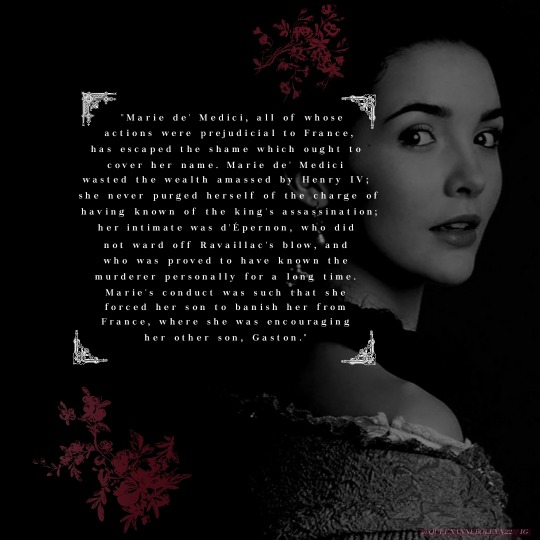
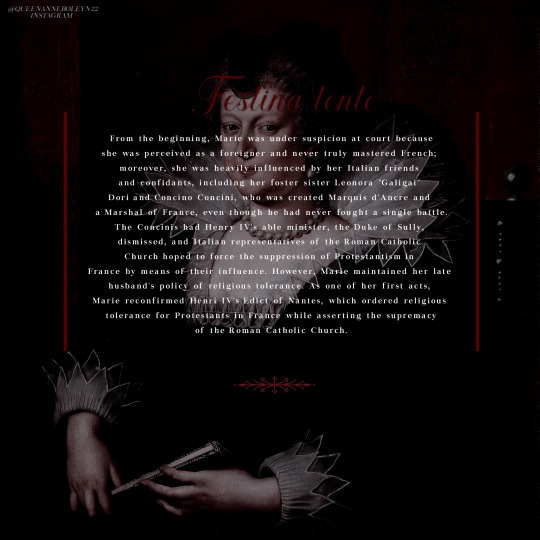
"The additional ingredient to this scenario was that the Guise possessed certain notable features that most other grandee families did not, their princely and trans- regional status. Their rank permitted access to the monarch that was unparalleled in most other court families, as ladies-in-waiting and holders of the highest court offices, but also merely as princely companions. They had strong links of blood and affinity with foreign powers, primarily in Italy, but also in Spain and the Empire.Guise women shared both these princely and trans- regional qualities with their male counterparts, and they came to the fore in a female- run court such as those of Marie de Medici and Anne of Austria. During periods of female rule normal lines of power and patronage thatradiate from a king to his most prominent male courtiers shift to a pattern of female alliances, as is seen notably in the reign of Elizabeth I of England. But these periods of female rule had their differences in seventeenth-century France. Katherine Crawford puts forward in her work on regencies that Marie de Medici overstepped her bounds as a female regent by presenting herself publicly as sharing royal authority with her son the King, whereas Anne of Austria always ensured that the public face of Bourbon authority was her son’s, never her own. By focusing on one of these matriarchs, the Dowager Duchess of Guise, Henriette-Catherine de Joyeuse, and her relationship with her son, Henri II, Duke of Guise, we can shed light on their conflicting interests between the dynastic and the personal, and in particular, in his personal ‘rêve italien’ versus the reputation of the family as a whole, in France and abroad, amongst the wider European society of princes."
Source: "Mother Knows Best: The Dowager Duchess of Guise, a Son’s Ambitions, and the Regencies of Marie de Medici and Anne of Austria" by Jonathan Spangler
#perioddramaedit#history#edit#history edit#marie de medici#marie de medicis#17th century#french history#women in history#women of history#anne of austria#historical#historical figures#queen#historical women#1600s#Bourbon#medici#historyedit#histoire#Graphic#history's women#baroque#marie of medici
71 notes
·
View notes
Text
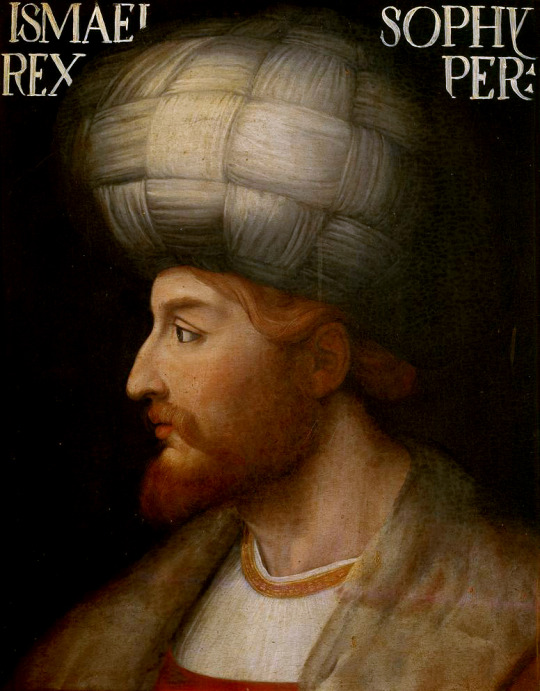
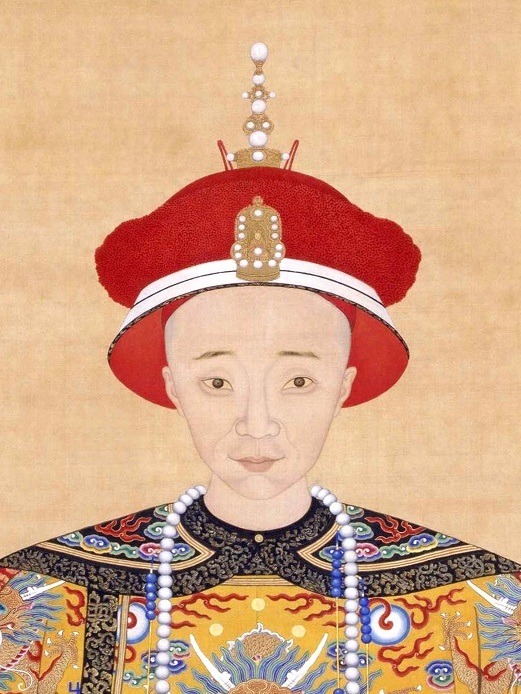
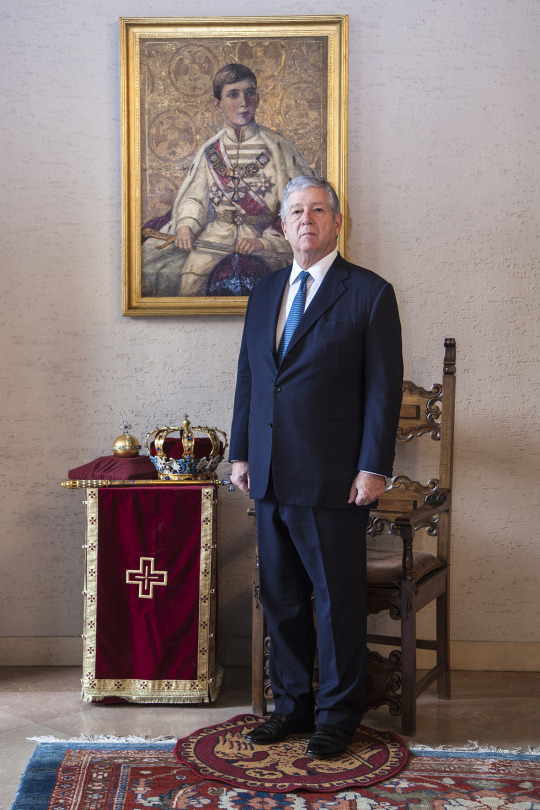



Royal Birthdays for today, July 17th:
Ismail I, Shah of Iran, 1487
Xianfeng Emperor, Emperor of China, 1831
Alexander, Crown Prince of Yugoslavia, 1945
Camilla, Queen Consort of the United Kingdom, 1947
Letsie III, King of Lesotho, 1963
Felipe de Marichalar y Borbón, Grandee of Spain, 1998
#ismail i#xianfeng emperor#crown prince alexander#camilla parker bowles#letsie iii#Felipe de Marichalar y Borbón#royal birthdays#long live the queue
7 notes
·
View notes
Text
Saint of the Day – 10 October – St Francis Borgia SJ (1510-1572) Confessor
Saint of the Day – 10 October – St Francis Borgia SJ (1510-1572) Confessor, Priest of the Society of Jesus, Advisor, Missionary, Evangelist, Administrator par excelleance. Francisco de Borja y Aragon was the 4th Duke of Gandía, was a Grandee of Spain, a Spanish Jesuit and third Superior General of the Society of Jesus
A continuation of the life of St Francis Borgia – an entire year has slipped…
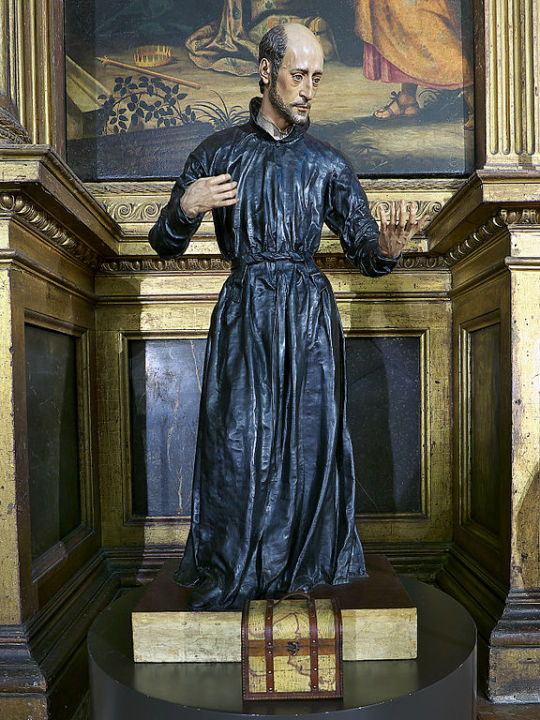
View On WordPress
2 notes
·
View notes
Text
PREDICTIONS of those in attendance of The Princess of Asturias's 18th birthday Celebrations
The Princess of Asturias's birthday celebration is meant to be a private affair, thus likely there will be limilted international affairs involved and it will primarily be a family affair, if anything we might get The Greeks as Queen Sofia is closely connected to them, and possibly the Bulgarian royals, especially with Prince Christian's celebrations just the week before.
Spain
King Felipe VI
Queen Letizia
Queen Sofia
King Juan Carlos
Infanta Elena, The Duchess of Lugo
Don Felipe Juan Froilán de Todos los Santos de Marichalar y Borbón, Lord of Tejada
Doña Victoria Federica de Todos los Santos de Marichalar y Borbón, Lady of Tejada
Infanta Cristina
Don Juan Valentín Urdangarin y Borbón
Don Pablo Nicolás Sebastián Urdangarin y de Borbón
Don Miguel Urdangarin y Borbón
Doña Irene Urdangarin y Borbón
Doña María de Fátima Simoneta Luisa Gómez-Acebo y Borbón(who's also celebrating her birthday)
Don Juan Filiberto Nicolás Gómez-Acebo y Borbón, 3rd Viscount of La Torre
Don Bruno Alejandro Gómez-Acebo y Borbón
Don Luis Beltrán Ataúlfo Alfonso Gómez-Acebo y Borbón
Don Fernando Humberto Gómez-Acebo y Borbón
Infanta Margarita of Spain, Duchess of Soria, 2nd Duchess of Hernani, Grandee of Spain
Don Carlos Emilio Juan Zurita y Delgado, Duke of Soria and Hernani
Don Alfonso Juan Carlos Zurita y de Borbón, Grandee of Spain
Doña María Sofía Emilia Carmen Zurita y de Borbón, Grandee of Spain
Queen Letizia's family
Jesús José Ortiz Álvarez
María de la Paloma Rocasolano Rodríguez
Telma Ortiz Rocasolano
Amanda Rocasolano
Carla Vigo Rocasolano
1 note
·
View note
Text
In terms of territory, it seems likely that the notables owned a greater proportion of the British Isles than almost any other elite owned of almost any other country [during the 19th century]. At the very bottom of the scale, in European Russia, the holdings of the old territorial establishment, although they amounted to a massive 177 million acres, made up only 14 per cent of the total land area of the nation. In France, there was by the nineteenth century no such entity as a landed interest, less than 20 per cent of the country was actually owned by the old elite, and in 1885, there were fewer than 1,000 estates of 1,000 acres. In Prussia, the Junkers owned perhaps 40 per cent of the land, but a large amount of this was in very small holdings of less than 1,000 acres. Likewise, in Spain, while 52 per cent of the country was covered by estates, much of it was made up of insubstantial plots. Compared with the landowning elites of these four countries, the British aristocracy was clearly pre-eminent. Indeed, it seems possible–but not certain–that it was the landowning classes only of Austria, Hungary, and Romania that could rival the territorial dominance of the British patrician classes in their heyday.
It also seems likely that the British gentry and grandees were, collectively speaking, the wealthiest of the European territorial elites. In part, this was because they came to the most profitable terms with the Industrial Revolution. Britain was, after all, the first nation to industrialize; the patricians themselves owned so much of the land surface; and they were more advantageously placed to exploit the minerals beneath than many continental owners. [...] Only in Eastern Europe were there to be found those vast accumulations, held by families like Sheremetev and Yusupov in Russia, and Esterhazy, Schwarzenberg, and Lichenstein in Austria-Hungary, that rivaled, and occasionally surpassed in acreage, the massive empires of the Sunderlands, the Breadalbanes, and the Buccleauchs. [...]
Compared with the titled and territorial classes of Belgium, France, Spain, Italy, and Russia, the British landed elite was more wealthy, more exclusive, and more powerful. And even compared with the more robust notabilities of Prussia, Roumania, and Hungary, it was probably richer, and certainly more exclusive, and exercised its power in a significantly different way. Above all, it was the preponderance of land in the British case that most stands out. It gave them so much wealth and such territorial pre-eminence. It was virtually impossible for a non-landed person to obtain a peerage. And it was the landed elite, not a separate service elite, that was in control of public affairs. In no other country in Europe were wealth, status, and power so highly correlated or so territorially underpinned. In addition, the British landed establishment had survived the revolutions of 1789 and 1848 unscathed, while other nobilities had been abolished or outlawed or had suffered an immense blow to their pride and prestige. In European terms, the British patricians were almost certainly the most illustrious and class conscious of them all.
The Decline and Fall of the British Aristocracy by David Cannadine (Yale University Press, 1990)
2 notes
·
View notes
Text
On this day in Wikipedia: Tuesday, 3rd October
Welcome, Willkommen, Bienvenue, Benvenuta 🤗
What does @Wikipedia say about 3rd October through the years 🏛️📜🗓️?
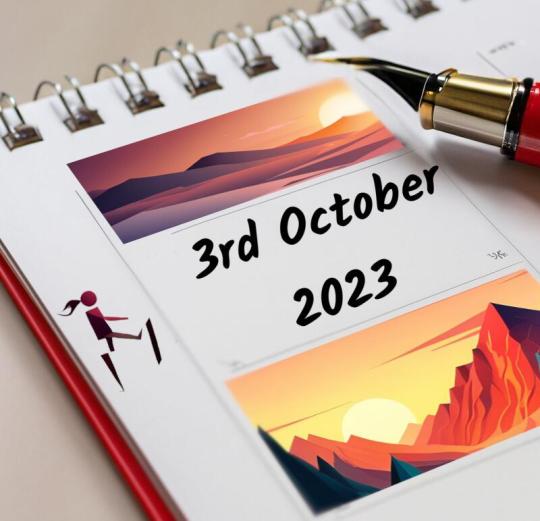
3rd October 2022 🗓️ : Event - Svante Pääbo
Svante Pääbo is awarded the Nobel Prize in Physiology or Medicine.
"Svante Pääbo (Swedish: [ˈsvânːtɛ̂ ˈpʰɛ̌ːbʊ̂]; born 20 April 1955) is a Swedish geneticist and Nobel Laureate who specialises in the field of evolutionary genetics. As one of the founders of paleogenetics, he has worked extensively on the Neanderthal genome. In 1997, he became founding director of..."

Image licensed under CC BY-SA 4.0? by Duncan.Hull
3rd October 2015 🗓️ : Event - Kunduz hospital airstrike
Forty-two people are killed and 33 go missing in the Kunduz hospital airstrike in Afghanistan.
"On 3 October 2015, a United States Air Force AC-130U gunship attacked the Kunduz Trauma Centre operated by Médecins Sans Frontières (MSF, or Doctors Without Borders) in the city of Kunduz, in the province of the same name in northern Afghanistan. 42 people were killed and over 30 were..."

Image licensed under CC BY 2.0? by © OpenStreetMap contributors
3rd October 2013 🗓️ : Event - 2013 Lampedusa migrant shipwreck
A boat carrying migrants from Libya to Italy sank off the Italian island of Lampedusa, resulting in more than 360 deaths.
"On 3 October 2013, a boat carrying migrants from Libya to Italy sank off the Italian island of Lampedusa. It was reported that the boat had sailed from Misrata, Libya, but that many of the migrants were originally from Eritrea, Somalia and Ghana. An emergency response involving the Italian Coast..."
3rd October 1973 🗓️ : Birth - Lena Headey
Lena Headey, British actress
"Lena Kathren Headey ( LEE-nə HEE-dee; born 3 October 1973) is a British actress. She gained international recognition and acclaim for her portrayal of Cersei Lannister on the HBO epic fantasy drama series Game of Thrones (2011–2019), for which she received five Primetime Emmy Award nominations and a..."

Image licensed under CC BY-SA 2.0? by Greg2600
3rd October 1923 🗓️ : Birth - Edward Oliver LeBlanc
Edward Oliver LeBlanc, Dominican lawyer and politician, 1st Premier of Dominica (d. 2004)
"Edward Oliver Le Blanc (3 October 1923 – 29 October 2004) was a Dominican politician. He served as the chief minister of Dominica from January 1961 to 1 March 1967 and as the first premier of Dominica from 1 March 1967 to 27 July 1974...."
3rd October 1804 🗓️ : Birth - Allan Kardec
Allan Kardec, French author, translator, educator and founder of modern Spiritism (d. 1869)
"Allan Kardec (French: [kaʁdɛk]) is the pen name of the French educator, translator, and author Hippolyte Léon Denizard Rivail ([ʁivaj]; 3 October 1804 – 31 March 1869). He is the author of the five books known as the Spiritist Codification, and the founder of Spiritism...."

Image
3rd October 🗓️ : Holiday - Christian feast day: Francis Borgia
"Francis Borgia (Valencian: Francesc de Borja; Spanish: Francisco de Borja; 28 October 1510 – 30 September 1572) was a Spanish Jesuit priest. The great-grandson of Pope Alexander VI, he was Duke of Gandía and a grandee of Spain. After the death of his wife, Borgia renounced his titles and became a..."

Image by Alonso Cano
0 notes
Text
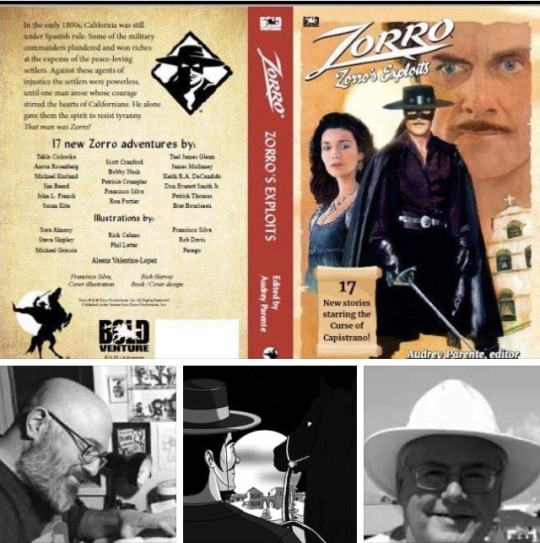
Boldventurepress.com
*ZORRO'S EXPLOITS anthology brings together talented authors and artists who have created exciting new tales about the first masked vigilante hero from the pulp fiction magazines — 17 action-packed short-story adventures. Watch as the first caped crusader breathes new life into history, challenges old enemies, encounters mythical creatures, fights demons, and finds humor in scuffles with bad guys.
**Find the book at https://www.boldventurepress.com/zorros-exploits/ or on Amazon.
***One of the astounding tales in ZORRO'S EXPLOITS is "Out of the Night," by John French, a retired crime scene supervisor who won the Pulp Factory Award for the best short story, “DEATH OF A GRANDEE" in 2021. "Out of the Night," turns a peaceful scene into terror in Los Angeles, when Don Diego Vega proposes to Senora Lolita Pulidos — and he promises to be Zorro no more. But an inhuman beast haunts the countryside around Los Angeles, and only Zorro can save the situation.
****The story is illustrated by cartoonist Michael Grassia, whose work has appeared in comics, children’s books, greeting cards, and more. Boldventurepress.com
#Zorro #ZorrosExploitsBook #ZorroBook #BoldVenturePress #BoldVenturePressZorro #DisneyZorro #NewWorldZorro #Bookpublisher #swashbuckler #California #Spain #Spanish
0 notes
Text

✵October 12, 1972 ✵
Infanta Margarita of Spain, Duchess of Soria, 2nd Duchess of Hernani, Grandee of Spain & Carlos Zurita y Delgado
8 notes
·
View notes
Photo

Alba Spanish Coronet Tiara ♕ Carlos Fitz-James Stuart, 19th Duke of Alba
#alba#duchess of alba#Duke of Alba#carlos fitz-james stuart#house of alba#spanish coronet tiara#coronet#diamond coronet#emerald coronet#emerald tiara#emerald jewelry#grandee of spain#spanish nobility#diamond jewels#royal jewels
60 notes
·
View notes
Photo
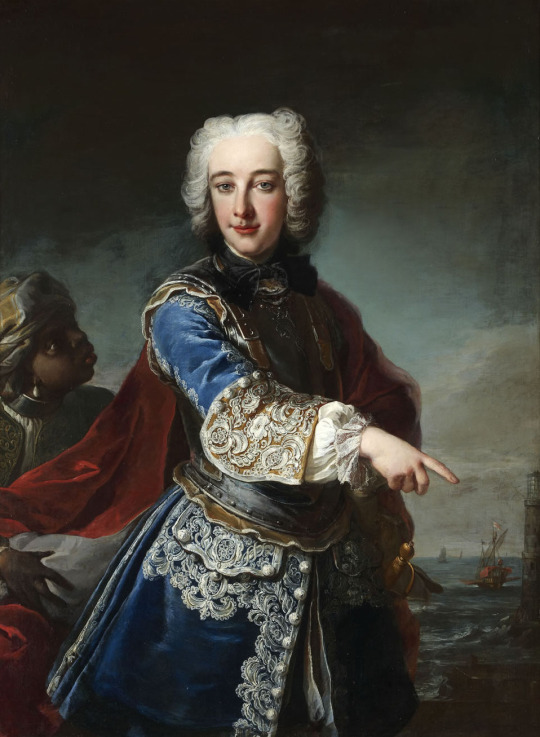
Louis-Michel van Loo (French, 1707 - 1771)
Aparece este cuadro en el catálogo de 1830, que dice: “Retrato del 3er Duque de Liria, en más de medio cuerpo, vestido de azul, con un negro a su espalda y señalando el mar.”
(This painting appears in the 1830 catalogue, which says: "Portrait of the 3rd Duke of Liria, in more than half length, dressed in blue, with a black man behind him and pointing to the sea), ca. 1725 - 50
Colección de la Fundación Casa de Alba
Jacobo Francisco Eduardo Fitz-James Stuart y Colón de Portugal, 3rd Duke of Berwick, 3rd Duke of Liria and Jérica, 9th Duke of Veragua, 9th Duke of la Vega (28 December 1718 – Valencia, 30 September 1785) was a Spanish Jacobite. On the death of his father, James Fitz-James Stuart, in 1738, he inherited his titles of Duke of Berwick and Duke of Liria and Xerica. (He also possessed many other titles in both Spain and England.) His mother was Spanish, and on her side he was a direct descendant of explorer Christopher Columbus.
On 26 July 1738, in Alba de Tormes, he married Maria Teresa de Silva y Alvarez de Toledo (6 May 1716 – 5 May 1790), daughter of Manuel Maria de Silva y Mendoza, (born 18 October 1677), 9th Conde de Galve, 7th son of the 5th Duke of Pastrana and Estremera and of the outstandingly wealthy Maria Teresa Alvarez de Toledo, (18 September 1691 – 1755), 11th Duquesa de Alba de Tormes, 8th duquesa de Huéscar, 4th Duquesa de Montoro, 6th Duquesa de Olivares, 7th Duquesa de Galisteo, Grandee of Spain, and a number of lesser Spanish noble titles (such as Marquessats, Earldoms, Baronetages, Viscountships and Lordships). Their only son to survive to adulthood was Carlos Bernardo Fitz-James Stuart y de Silva, (Liria, Valencia, 25 March 1752 – Madrid, 7 September 1787).
Titles: 3rd Duke of Berwick, 3rd Duke of Liria and Xérica, Grandee of Spain 1st Class, 10th Duke of Veragua, 10th Duke of la Vega, 3rd Earl of Tinmouth, 9th Count of Gelves, 3rd Baron Bosworth.
#wish i had that many titles#art#classical art#louis michel van loo#french#france#french art#french man#male#portrait#man#powdered wig#europe#european#european art#english#spanish#spain#classical#portugal#western europe#18th century#1700s#fine art#fine arts#traditional art#western civilization#western culture
19 notes
·
View notes
Photo
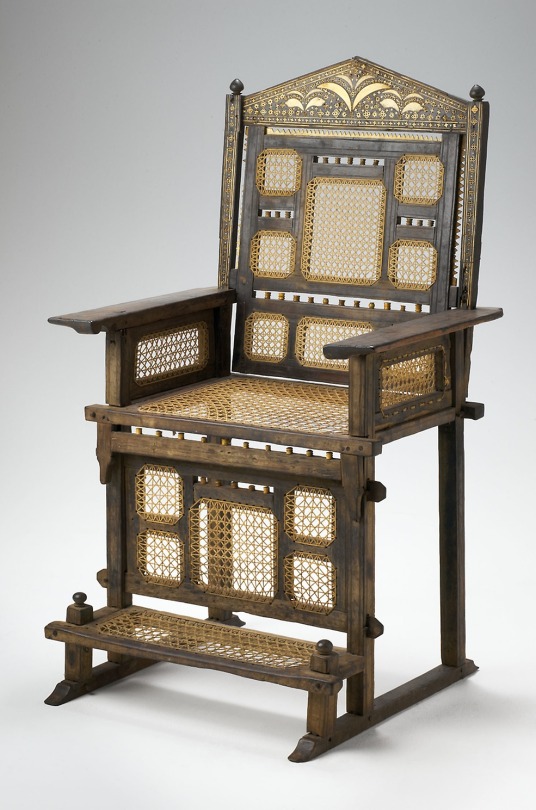
Chair (Kiti Cha Enzi), Swahili, 1801, Art Institute of Chicago: Arts of Africa
This style of high-backed seat with bone and ivory inlay, known as a “chair of power” or “grandee’s chair” (kiti cha enzi), is a graphic reminder of the complex history of international trade and conquest in the region known as the Swahili Coast. As early as the first century, the region’s natural harbors invited exchange with partners in the Persian Gulf and Western India. Later the Portuguese, Omani, and British imposed their authority on its inhabitants. With each conquering state, newly imported goods and practices took root as symbols of authority and power among the Swahili elite. The upright form of the kiti cha enzichair bears strong resemblance to sixteenth- and seventeenth-century chairs imported from Portugal and Spain, as well as to Portuguese- and Spanish-influenced examples made in India. Comparisons have also been made with chairs from the Mamluk period (1250–1517) in Egypt. In any case, the Swahili version is clearly the result of foreign influences that have been artfully synthesized and reshaped by local artisans. Most such chairs in collections today date from the nineteenth century and were made in large, specialized workshops. They could be found conspicuously displayed in wealthy households along the Swahili Coast into the first half of the twentieth century. Restricted gift of Marshall Field V
Size: 125.7 × 75.6 × 72.4 cm (49 1/2 × 29 3/4 × 28 1/2 in.)
Medium: Wood, ivory, and cotton fiber
https://www.artic.edu/artworks/183077/
40 notes
·
View notes
Photo

“28 November 1750
The new Comtesse de la Marck, born a Noailles, makes her first appearance at court since the death of her father-in-law. She takes her tabouret, in her quality as a Grandee of Spain, first in the King’s apartments and then in the Queen’s. One does not kiss the hem of the Queen’s dress on these occasions. She is presented by her sister, the Duchesse de Villars.*
A tabouret is an upholstered stool. Relatively few ladies at court have the right to sit on one in the royal apartments: Princesses of the Blood, duchesses, foreign princesses, and, it seems, Grandees of Spain. Mme de la Marck, a Frenchwoman, is a Grandee by her marriage to the Comte de la Marck, whose recently deceased father received the grandeeship when he was French ambassador in Madrid.
*Memoirs of the Duc de Luynes
Pictured: Tabourets in the bedchamber of the Queens and Empresses at Fontainebleau.
Credit: Own photo taken onsite in April, 2018.”
Source (Text and Image): Versailles Century
#Versailles Century#Fontainebleau#Rococo#Comtesse de la Marck#Memoirs of the Duc de Luynes#Interior#Decór#The Monarch#killem-all-if-they-wont-eat-cake
11 notes
·
View notes
Text
Saint of the Day – 10 October – The Childhood and Youth of St Francis Borgia SJ (1510-1572) Confessor and a note on Monthly Patrons
Saint of the Day – 10 October – The Childhood and Youth of St Francis Borgia SJ (1510-1572) Confessor and a note on Monthly Patrons
Saint of the Day – 10 October – St Francis Borgia SJ (1510-1572) Confessor, Priest of the Society of Jesus, Advisor, Missionary, Evangelist, Administrator par excelleance. Francisco de Borja y Aragon was the 4th Duke of Gandía, was a Grandee of Spain, a Spanish Jesuit and third Superior General of the Society of Jesus
“St Francis instituted at his Court, before he entered the religious life, the…
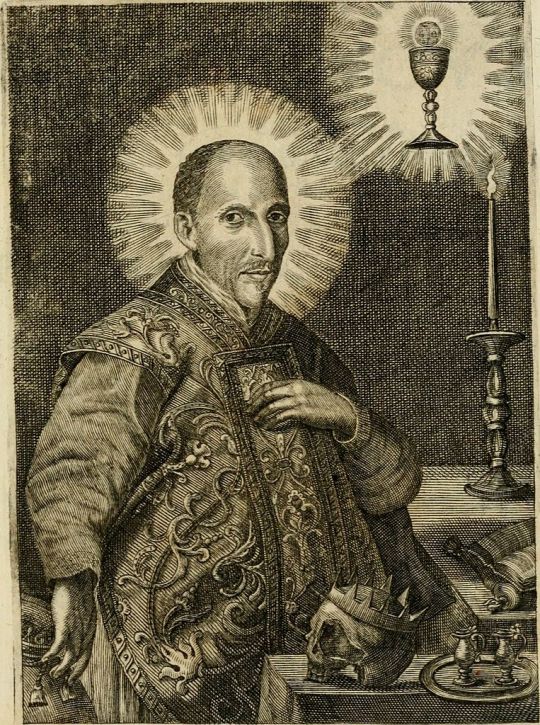
View On WordPress
3 notes
·
View notes